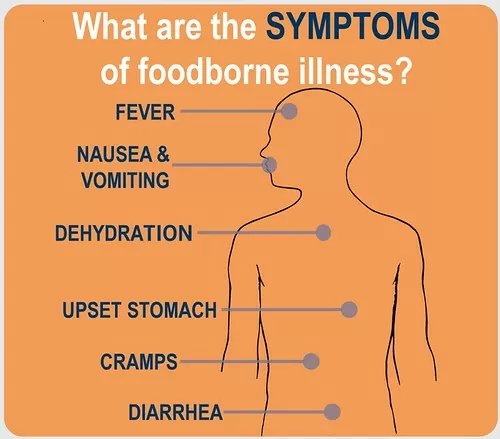What are the signs and symptoms of common foodborne illnesses?


Foodborne illnesses are a common occurrence and can cause significant discomfort and health issues. These illnesses are caused by consuming contaminated food or beverages, which can contain harmful bacteria, viruses, parasites, or toxins. The signs and symptoms of foodborne illnesses can vary depending on the specific pathogen involved, but there are some common indicators to look out for. In this article, we will explore the signs and symptoms of common foodborne illnesses, including bacterial and viral infections, gastroenteritis, and the associated symptoms such as diarrhea, vomiting, and nausea.
Bacterial Infections:
Bacterial infections are one of the most common causes of foodborne illnesses. Some of the common bacteria that can cause these infections include Salmonella, Campylobacter, E. coli, and Listeria. The symptoms of bacterial infections usually appear within a few hours to a few days after consuming contaminated food. These symptoms may include:
1. Diarrhea: Diarrhea is a common symptom of bacterial infections. It can range from mild to severe and may be accompanied by abdominal cramps and pain.
2. Vomiting: Vomiting is another common symptom of bacterial infections. It can be persistent and may lead to dehydration if not managed properly.
3. Nausea: Nausea is often experienced along with diarrhea and vomiting in cases of bacterial infections. It can be a result of the body’s response to the toxins produced by the bacteria.
4. Fever: Fever is a common sign of bacterial infections. It is the body’s natural response to fight off the infection.
Viral Infections:
Viral infections can also cause foodborne illnesses. Some of the common viruses that can be transmitted through contaminated food include norovirus, rotavirus, and hepatitis A. The symptoms of viral infections may take longer to appear compared to bacterial infections and can include:
1. Diarrhea: Diarrhea is a common symptom of viral infections. It can be watery and may last for several days.
2. Vomiting: Vomiting is another common symptom of viral infections. It can be severe and may occur frequently.
3. Nausea: Nausea is often experienced along with diarrhea and vomiting in cases of viral infections. It can be a result of the body’s response to the viral invasion.
4. Fever: Fever is a common sign of viral infections. It is the body’s natural response to fight off the infection.
Gastroenteritis:
Gastroenteritis is a condition characterized by inflammation of the stomach and intestines. It can be caused by both bacterial and viral infections. The symptoms of gastroenteritis can include:
1. Diarrhea: Diarrhea is a common symptom of gastroenteritis. It can be watery or bloody, depending on the underlying cause.
2. Vomiting: Vomiting is another common symptom of gastroenteritis. It can be persistent and may lead to dehydration if not managed properly.
3. Nausea: Nausea is often experienced along with diarrhea and vomiting in cases of gastroenteritis. It can be a result of the body’s response to the inflammation in the digestive system.
4. Abdominal pain: Abdominal pain and cramps are common symptoms of gastroenteritis. They can range from mild to severe and may be accompanied by bloating and discomfort.
Prevention and Treatment:
Preventing foodborne illnesses is essential for maintaining good health. Here are some preventive measures you can take:
1. Practice good hygiene: Wash your hands thoroughly before handling food and after using the bathroom. Clean and sanitize kitchen surfaces and utensils regularly.
2. Cook food thoroughly: Ensure that food is cooked at the right temperature to kill any harmful bacteria or viruses.
3. Store food properly: Refrigerate perishable foods promptly and avoid consuming expired or spoiled food.
4. Be cautious when eating out: Choose reputable establishments that follow proper food safety practices.
If you suspect that you have a foodborne illness, it is important to seek medical attention. Treatment may involve rehydration to replace lost fluids and electrolytes, and in some cases, antibiotics may be prescribed to treat bacterial infections.
In conclusion, foodborne illnesses can cause a range of symptoms, including diarrhea, vomiting, and nausea. Bacterial and viral infections, as well as gastroenteritis, are common causes of these illnesses. By practicing good hygiene, cooking food thoroughly, and being cautious when eating out, you can reduce the risk of foodborne illnesses. If you experience symptoms of a foodborne illness, it is important to seek medical attention for proper diagnosis and treatment.
Recent Posts
How do I create an engaging and informative online quiz or assessment?
Creating an engaging and informative online quiz or assessment can be a powerful tool for… Read More
What are the most effective methods for managing and reducing work-related stress in the hospitality industry?
Work-related stress is a common issue in the hospitality industry, where employees often face long… Read More
How can I improve my assertiveness and communication skills in a leadership position?
In a leadership position, assertiveness and effective communication skills are crucial for success. Being able… Read More
What are the key elements of a successful employee recognition and rewards program?
Employee recognition and rewards programs play a crucial role in motivating and engaging employees, as… Read More
How do I effectively manage and respond to customer feedback and reviews?
Customer feedback and online reviews play a crucial role in shaping a company's reputation and… Read More
What are the best strategies for effective time management as a stay-at-home parent?
Effective time management is crucial for stay-at-home parents who juggle multiple responsibilities on a daily… Read More